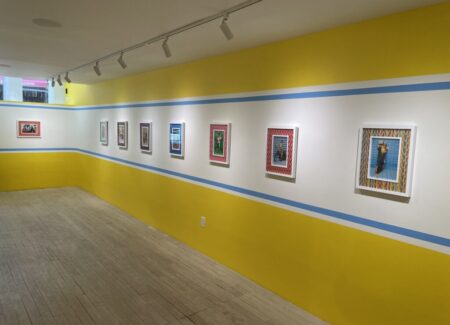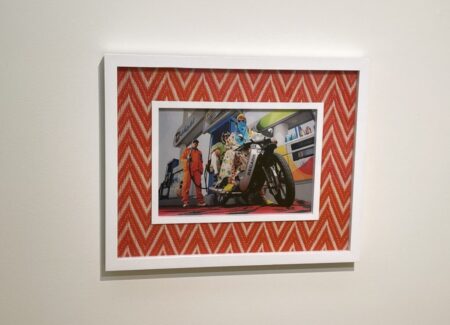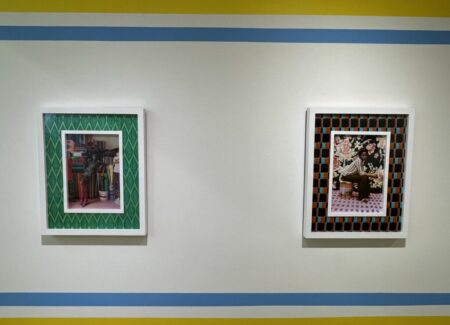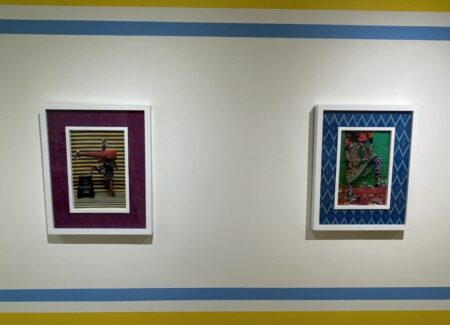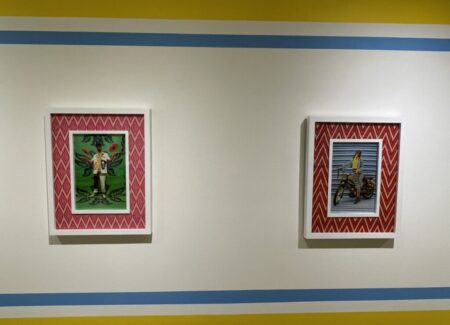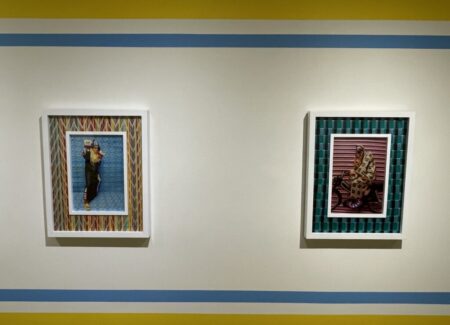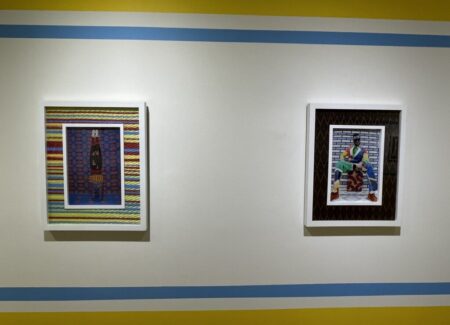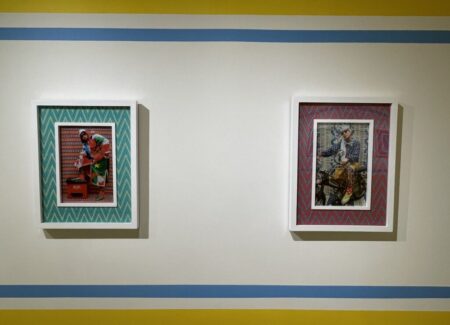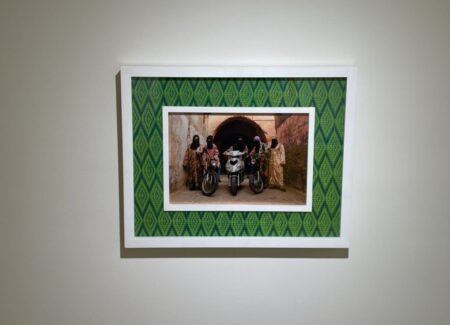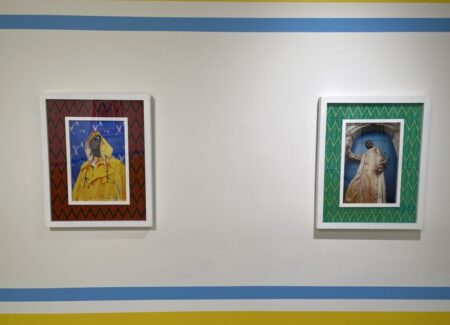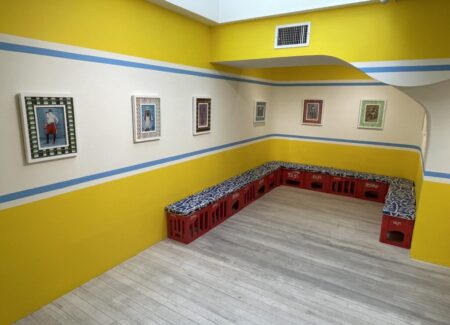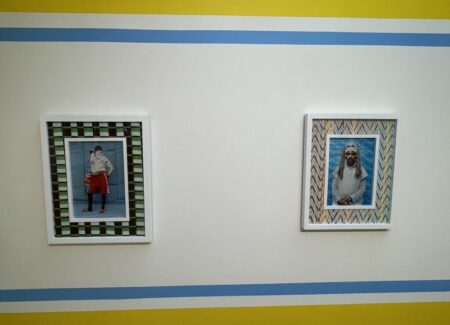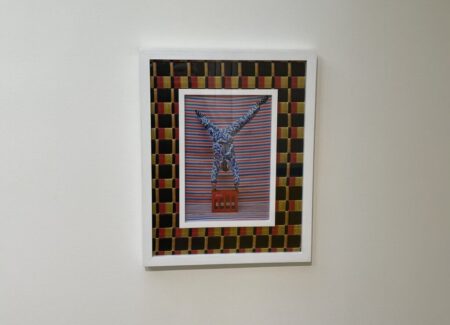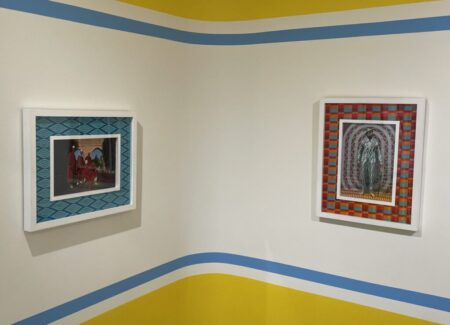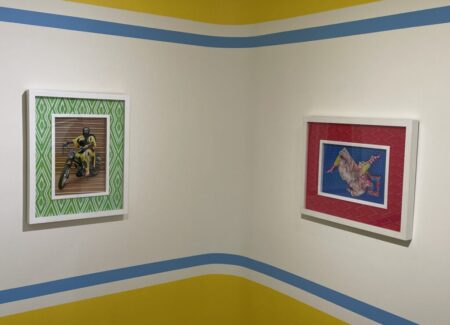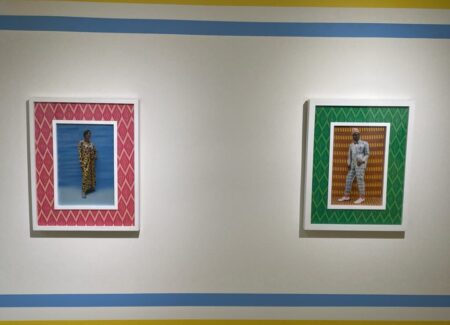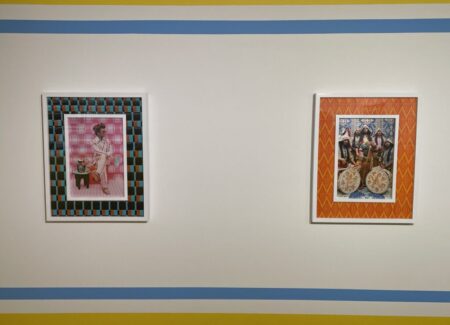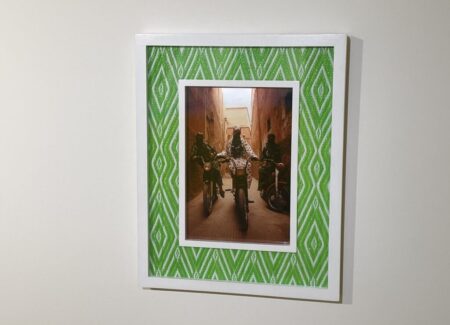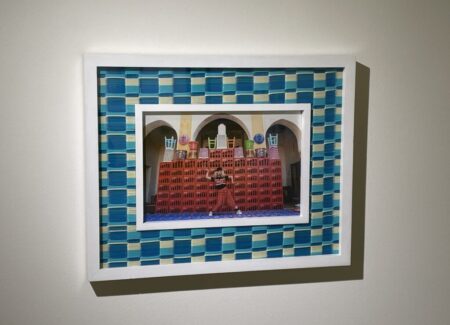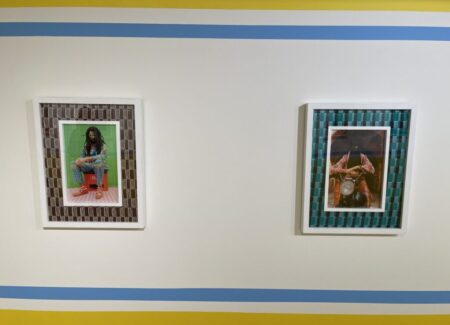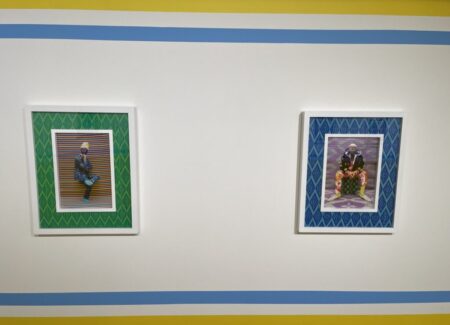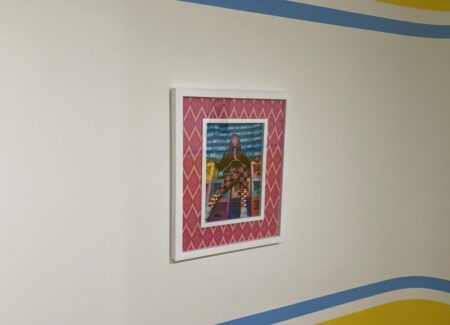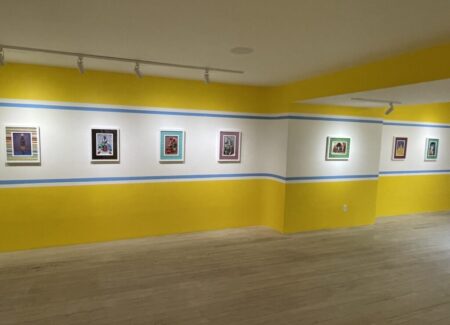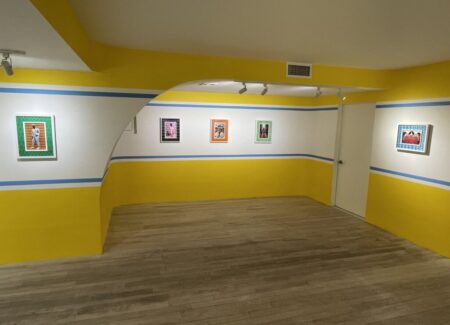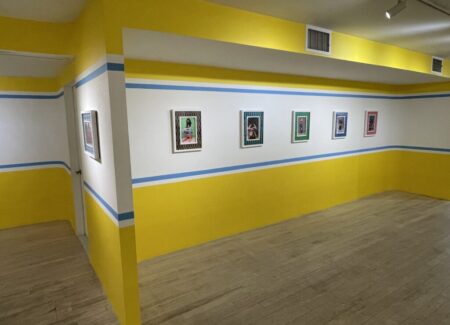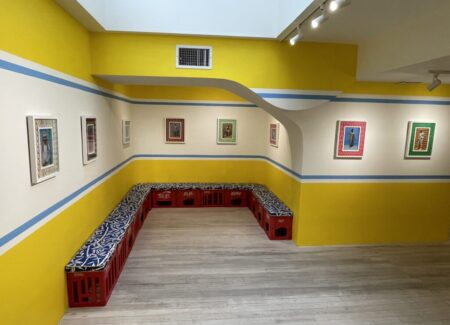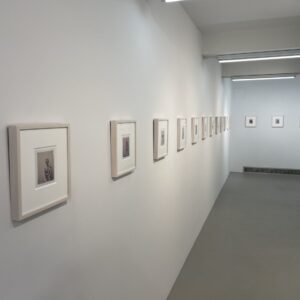JTF (just the facts): A total of 39 color photographs, framed in white, and hung against white walls with yellow and blue stripes in the main gallery space. The installation also includes a seating area made from red plastic Coca-Cola bottle crates and printed cushions. (Installation shots below.)
All of the works are metallic Lambda prints with plastic mat, wood, and Perspex, made in 1999, 2000, 2006, 2008, 2010, 2011, 2012, 2013, 2014, 2015, 2016, 2018, 2019, 2020, or 2022. Each work is sized roughly 20×16, 20×15, 19×15, 18×15, 14×19, 15×18, or 15×19 inches, and all of the works are unique.
Comments/Context: Over the past decade or two, few contemporary photographers have delivered blasts of contagious visual exuberance as consistently as Hassan Hajjaj. Working along the aesthetic edges of fashion photography and global streetstyle, the Moroccan photographer’s portraits are filled with swagger, energy, performative individuality, and riotous color, capturing a parade of people he has called “My Rockstars”. His reach spans the known and unknown, including celebrities, models, artists, actors, musicians, DJs, and other friends and muses from around the globe, who once inside his self-contained world of intermingled traditional patterns and pop culture references seem to sparkle and shine with personal optimism and spirit.
Hajjaj’s shows typically thrum with eye-popping vitality and welcoming inclusiveness, nearly always including walls painted in bright colors and cozy seating areas made from plastic crates. This kind of celebratory atmosphere was found in gallery installations in 2014 (reviewed here) and 2021 (reviewed here), as well as in his 2021 museum survey at Fotografiska (reviewed here), and has been re-established here with bold stripes in lemon yellow and ocean blue, providing a sense of embracing warmth in the blustery cold of the New York winter.
What’s immediately apparent about this show, particularly in comparison to his earlier efforts, is the sense of scale. In the past, Hajjaj’s artworks have generally been shown decently large, sometimes at nearly life size, with the prints then surrounded by gridded niches filled with pop culture items like soda cans, food tins, plastic toys, and other boldly graphic objects, which have further amplified the overall cacophony of color and pattern taking place. The resulting works have delivered both a physical presence on a wall or in a gallery space and a sculptural object quality when examined more closely, almost like jaunty contemporary shrines to the people who have been captured by Hajjaj’s camera.
In this show, Hajjaj has scaled down his images significantly, presenting them as works that are much smaller and more intimate, eliminating the surrounding niches of physical objects and matting his photographs with the plastic outdoor mats commonly used in Morocco. Made to withstand the sun and rain, these woven mats come in a range of bright colors and geometric patterns, and Hajjaj has used them as a kind of frame-within-a-frame visual ground, a base against which his vibrant photographs can then react. It’s a smart solution for framing these smaller works and making them unique, in a way that naturally amplifies his fundamental photographic interests in layered contrasts and found materials.
Hajjan has essentially gone back through his entire archive and reprinted some of his most notable images in this smaller size, so many pictures will be familiar to those who have seen some his previous shows, although they have been now reinterpreted in a fresh way with the plastic mats. A few images reach all the way back to the early 2000s, when Hajjaj was still figuring out his signature aesthetic; these pictures feature figures in colored robes posed in the streets, where painted doors and open archways provide the background and context for the portraits.
Hajjaj’s artistic breakout came a few years later with his “‘Kesh Angels” – portraits of women on their motorcycles and the broader female biker culture in Marrakesh, where the swagger of big sunglasses and designer logos was mixed with brightly colored headscarves and robes in ways we really hadn’t seen before. The motorcycles were far more than props – they were symbols of independence and fashionable coolness that brashly pushed back on the male dominance of traditional Muslim culture. Hajjaj initially made these portraits out in the streets, in alleys, or at gas stations, but eventually a few migrated into a more controlled studio setting, where patterned backdrops and even more stylized looks amplified the confident mood further. And while Hajjaj went on to refine and solidify his signature aesthetics in the following years, these photographs remain some of his most iconic, making the new interpretations with the colorful plastic mat patterns feel like fresh riffs on old favorites.
In the past decade, Hajjaj’s mature style has become increasingly controlled, with every detail of clothing, sets, and surroundings carefully chosen to reflect the amplified energy of a sitter’s personality. Dapper custom suits, patterned socks, colorful leather slippers, robes made from national flags, luxury logo patterns fashioned into traditional garb – the options have been at once limitless and tightly edited. A small number of props have also started to appear, from red vinyl records (tossed in the air in a portrait of DJ Key) to boxing gloves, with umbrellas, hats, and traditional drums all making appearances. And in a few cases, the now familiar plastic crates resurface, as do colorful plastic stools and laundry baskets, offering additional possibilities for simple sitting, leaning, and posing.
A 2019 self-portrait of Hajjaj flipped over and making 90-degree angle with his body headlines a small subset of pictures that feature more elaborate poses and physical acrobatics. Other works capture handstands on boxes (with legs spread widely) or in baskets (with legs held tightly together), and a sitting pose, with one leg across another, but without the support of a chair. In one case, Hajjaj changes his camera position and looks straight down at a lounging subject, whose arms and legs twist outwards in a flattened swirl. These kinds of poses add further vitality to scenes already brimming with clashing colors and patterns, making them all the more joyously performative.
While Hajjaj’s large portraits certainly deliver jolts of visual dynamism, these smaller works feel even more easy going and personal, in a manner similar to Malick Sidibé’s studio portraits embellished with hand-painted glass. Here, the plastic mat patterns seem to have been chosen for maximum contrast and color friction with the central photographs, making each piece pop with feisty spirit. But the resulting works still require close engagement, making them perfect for smaller walls where viewers can get up close. This gives them an almost jewel box feel, where the long distance engagement with the sitter is almost like a secret conversation.
Collector’s POV: The works in this show are priced at $3500 each. Hajjaj’s work has little secondary market history at this point, so gallery retail likely remains the best option for those collectors interested in following up.
